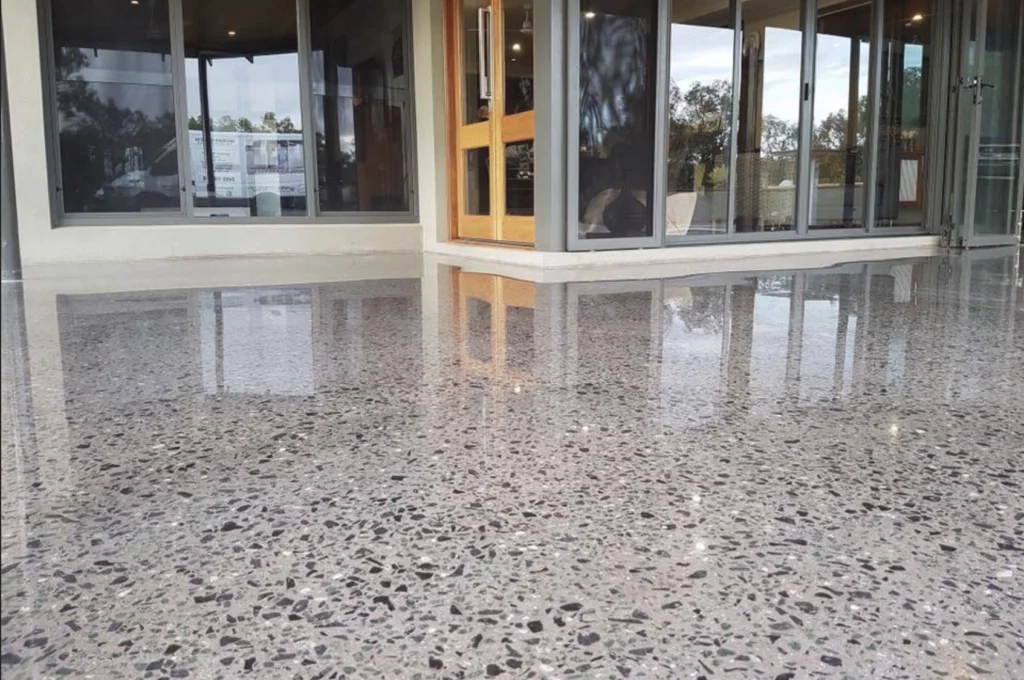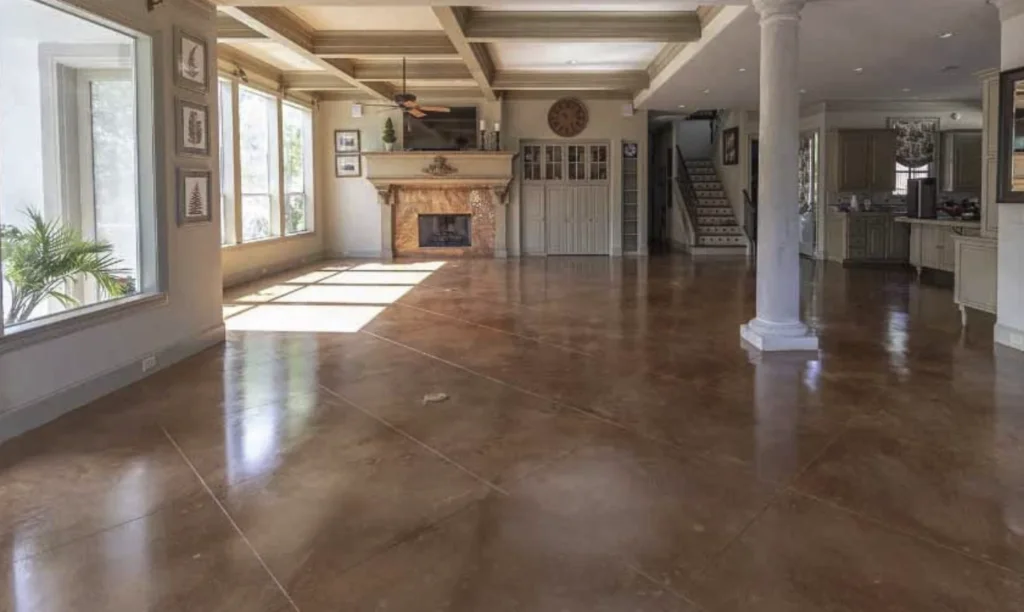Concrete flooring has become increasingly popular for both residential and commercial spaces, offering a unique blend of style, durability, and practicality. But is it the right choice for your needs? In this article, we’ll dive into the pros and cons of concrete floors, helping you weigh the benefits and drawbacks before making a decision.
There is a lot to consider when choosing the right flooring material for your home or office. Concrete has gained popularity for its modern aesthetic and practical benefits. However, like any material, it has its share of pros and cons. In this article, we’ll explore the advantages and disadvantages of concrete flooring, so you can make an informed decision.
What Is Concrete Flooring?
Concrete flooring is exactly what it sounds like—a floor made from concrete. This material is a mixture of cement, water, and aggregates like sand, gravel, or stone. When poured and cured properly, it creates a solid, durable surface that can be customized in various ways to suit different styles.
Common Uses of Concrete Flooring
Concrete flooring is commonly found in industrial and commercial buildings, but it’s increasingly being used in homes, especially in basements, garages, and modern living areas. Its versatility and strength make it ideal for high-traffic areas and spaces requiring minimal maintenance.
Advantages of Concrete Flooring
1. Durability
Concrete floors are renowned for their durability. Unlike other materials, concrete can withstand heavy foot traffic, machinery, and daily wear and tear without showing signs of damage. It’s an excellent choice for commercial spaces like warehouses and factories, as well as homes with pets or active families.
2. Cost-Effective
When comparing costs over time, concrete flooring can be more affordable than other options. The initial installation might be higher, but its longevity means fewer replacements or repairs, saving money in the long run. Properly maintained, a concrete floor can last for decades, making it a cost-efficient choice.
3. Low Maintenance
Once sealed, concrete floors require minimal upkeep. Regular sweeping and occasional mopping are usually all that’s needed to keep them looking fresh. Spills should be cleaned up quickly to avoid staining, and the floor may need resealing every few years, but overall, maintenance is simple and straightforward.

4. Versatility in Design
Concrete floors aren’t limited to a dull, gray finish. They can be polished to a high shine, stained in various colors, or textured for a more rustic look. This adaptability allows you to create a floor that matches your personal style or the decor of your space.
Staining and Coloring Options
Stained concrete floors can mimic the appearance of marble, stone, or even wood, giving you plenty of creative freedom. With acid staining or water-based dyes, the concrete can be transformed into a variety of vibrant hues.
Polishing for a Sleek Look
If you prefer a minimalist, modern aesthetic, polished concrete is a popular choice. The smooth, glossy surface reflects light and gives any space a sophisticated feel, making it a favorite for chic, contemporary homes and offices.
5. Eco-Friendliness
Concrete is an eco-friendly flooring option when you consider its sustainability and long lifespan. Since it doesn’t need to be replaced frequently and is made from readily available materials, it has a smaller environmental footprint compared to other flooring types.
6. Indoor and Outdoor Applications
Concrete can be used both indoors and outdoors, making it versatile. It’s ideal for patios, pool decks, and driveways, as well as interiors like living rooms, kitchens, and even bathrooms.
Disadvantages of Concrete Flooring

1. Cold and Unwelcoming Feel
One of the biggest drawbacks of concrete flooring is that it can feel cold underfoot. This makes it less appealing for spaces like bedrooms or living rooms where warmth and comfort are key. Radiant heating systems can be installed to counter this issue, but it adds to the cost.
2. Hard Surface
Concrete’s toughness can be a double-edged sword. While it’s durable, it’s also very hard, making it uncomfortable to stand on for long periods. Falls on concrete can also result in more serious injuries compared to softer flooring materials like carpet or wood.
3. Installation Challenges
Installing a concrete floor is a labor-intensive process that requires precision and expertise. Improper installation can lead to issues like cracking and uneven surfaces, so it’s best left to professionals.
4. Moisture Sensitivity
Concrete is porous, meaning it can absorb moisture if not properly sealed. Over time, moisture can seep through small cracks or openings, leading to mold and mildew growth, which can cause health problems if left unchecked.
5. Susceptibility to Cracking
Even with proper installation, concrete floors are prone to cracking. Temperature changes, settling of the building, or heavy loads can all cause cracks to form over time. However, these cracks can usually be repaired without replacing the entire floor.
How to Address Concrete Flooring Drawbacks

1. Adding Radiant Heating
If cold floors are a concern, radiant heating is a fantastic solution. It’s installed beneath the floor and evenly distributes heat, making the surface more comfortable in colder months.
2. Using Area Rugs for Comfort
Placing rugs or mats in high-traffic areas or places where people stand for long periods can help mitigate the hardness of the concrete. It also adds warmth and a touch of softness to the space.
3. Sealing and Regular Maintenance
Regularly sealing your concrete floor will help protect it from moisture and stains. This maintenance step is essential for keeping the floor in good condition over the years.
4. Crack Repairs
Addressing small cracks as soon as they appear will prevent them from worsening. Professional inspections and repairs can help keep the floor in top shape and avoid moisture issues.
Concrete Flooring for Different Spaces
1. Living Areas
Polished or stained concrete can work beautifully in living rooms and open spaces, giving a sleek and modern appearance.
2. Garages and Basements
Concrete is a natural choice for garages and basements due to its durability and resistance to heavy loads and moisture.
3. Commercial and Industrial Spaces
Concrete’s toughness and low maintenance requirements make it perfect for industrial environments, warehouses, and even retail spaces.
Design Considerations for Concrete Flooring
Choosing the Right Finish
Whether you want a glossy finish or a matte one, concrete offers various finishing options that can match the aesthetic of any room.
Color Schemes
Using stains or dyes, concrete floors can be customized to fit almost any color scheme, from neutral grays and browns to bold reds and blues.
Integration with Other Materials
Concrete works well with other materials like wood, stone, or metal, giving your space a mixed-material look that’s both stylish and functional.
Concrete Flooring Costs
Upfront Installation Costs
The initial cost of concrete flooring varies depending on factors like square footage, finish type, and whether you need professional installation. On average, it can be more expensive than carpet or vinyl but less than hardwood or stone.
Long-Term Maintenance Costs
Although the initial investment may be higher, the long-term maintenance costs of concrete floors are lower than other flooring materials. Its durability and easy upkeep make it a cost-effective option over time.
Is Concrete Flooring Right for You?
Before deciding on concrete flooring, ask yourself some key questions: Do you value durability over comfort? Are you looking for a modern aesthetic? How important is low maintenance to you? Answering these will help you determine if concrete flooring fits your lifestyle.
Closing Thoughts
Concrete flooring offers a blend of durability, style, and cost-effectiveness that’s hard to beat. However, it’s essential to weigh the drawbacks like its hardness and coldness before making a final decision. With the right approach and proper maintenance, concrete can be a fantastic flooring option that lasts for decades.
FAQs
1. How long do concrete floors last?
With proper maintenance, concrete floors can last 50 to 100 years or more, making them one of the most durable flooring options available.
2. Can concrete floors be refinished?
Yes, concrete floors can be refinished through polishing, staining, or applying a new sealant to restore their appearance.
3. Are concrete floors prone to cracking?
While concrete floors are tough, they can develop cracks over time due to settling or temperature fluctuations. Regular inspections can help prevent major damage.
4. How do I clean and maintain concrete floors?
Concrete floors are easy to maintain with regular sweeping and mopping. Sealing the surface every few years will help protect it from stains and moisture.
5. Can you install concrete flooring yourself?
Installing concrete flooring is a complex process best left to professionals. Improper installation can lead to cracking and other issues down the road.
